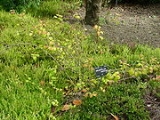
Abeliophyllum
Encyclopedia
Abeliophyllum is a monotypic genus of flowering plant
s in the olive
family, Oleaceae
. It consists of one species, Abeliophyllum distichum Nakai (Korean Abelialeaf), endemic to Korea
, where it is endangered
in the wild, occurring at only seven sites. It is related to Forsythia
, but differs in having white, not yellow, flowers.
It is a deciduous
shrub
growing to 1–2 m tall. The leaves
are opposite, simple, 6–10 cm long and 3-4.5 cm wide, pubescent both above and below. The flower
s are produced in early spring before the new leaves appear; they are white and fragrant, about 1 cm long, with a four-lobed corolla. The fruit
is a round, winged samara
2–3 cm diameter.
It is cultivated as an ornamental plant
in Europe and North America.
.
Flowering plant
The flowering plants , also known as Angiospermae or Magnoliophyta, are the most diverse group of land plants. Angiosperms are seed-producing plants like the gymnosperms and can be distinguished from the gymnosperms by a series of synapomorphies...
s in the olive
Olive
The olive , Olea europaea), is a species of a small tree in the family Oleaceae, native to the coastal areas of the eastern Mediterranean Basin as well as northern Iran at the south end of the Caspian Sea.Its fruit, also called the olive, is of major agricultural importance in the...
family, Oleaceae
Oleaceae
Oleaceae are a family containing 24 extant genera and around 600 species of mesophytic shrubs, trees and occasionally vines. As shrubs, members of this family may be twine climbers, or scramblers.-Leaves:...
. It consists of one species, Abeliophyllum distichum Nakai (Korean Abelialeaf), endemic to Korea
Korea
Korea ) is an East Asian geographic region that is currently divided into two separate sovereign states — North Korea and South Korea. Located on the Korean Peninsula, Korea is bordered by the People's Republic of China to the northwest, Russia to the northeast, and is separated from Japan to the...
, where it is endangered
Endangered species
An endangered species is a population of organisms which is at risk of becoming extinct because it is either few in numbers, or threatened by changing environmental or predation parameters...
in the wild, occurring at only seven sites. It is related to Forsythia
Forsythia
Forsythia is a genus of flowering plants in the family Oleaceae . There are about 11 species, mostly native to eastern Asia, but one native to southeastern Europe. The common name is also Forsythia; the genus is named after William Forsyth.-Growth:They are deciduous shrubs typically growing to a...
, but differs in having white, not yellow, flowers.
It is a deciduous
Deciduous
Deciduous means "falling off at maturity" or "tending to fall off", and is typically used in reference to trees or shrubs that lose their leaves seasonally, and to the shedding of other plant structures such as petals after flowering or fruit when ripe...
shrub
Shrub
A shrub or bush is distinguished from a tree by its multiple stems and shorter height, usually under 5–6 m tall. A large number of plants may become either shrubs or trees, depending on the growing conditions they experience...
growing to 1–2 m tall. The leaves
Leaf
A leaf is an organ of a vascular plant, as defined in botanical terms, and in particular in plant morphology. Foliage is a mass noun that refers to leaves as a feature of plants....
are opposite, simple, 6–10 cm long and 3-4.5 cm wide, pubescent both above and below. The flower
Flower
A flower, sometimes known as a bloom or blossom, is the reproductive structure found in flowering plants . The biological function of a flower is to effect reproduction, usually by providing a mechanism for the union of sperm with eggs...
s are produced in early spring before the new leaves appear; they are white and fragrant, about 1 cm long, with a four-lobed corolla. The fruit
Fruit
In broad terms, a fruit is a structure of a plant that contains its seeds.The term has different meanings dependent on context. In non-technical usage, such as food preparation, fruit normally means the fleshy seed-associated structures of certain plants that are sweet and edible in the raw state,...
is a round, winged samara
Samara (fruit)
A samara is a type of fruit in which a flattened wing of fibrous, papery tissue develops from the ovary wall. A samara is a simple dry fruit and indehiscent . It is a winged achene...
2–3 cm diameter.
It is cultivated as an ornamental plant
Ornamental plant
Ornamental plants are plants that are grown for decorative purposes in gardens and landscape design projects, as house plants, for cut flowers and specimen display...
in Europe and North America.
Conservation status
In 1998, a review of the plant's conservation status found that "it is close to extinction and qualifies for the IUCN Category of 'Critically Endangered', indicating a high risk of extinction in the near future."; but as of 2009 it has not yet been formally assessed for the IUCN Red ListIUCN Red List
The IUCN Red List of Threatened Species , founded in 1963, is the world's most comprehensive inventory of the global conservation status of biological species. The International Union for Conservation of Nature is the world's main authority on the conservation status of species...
.

